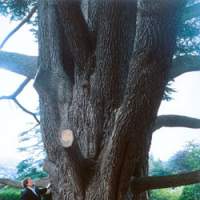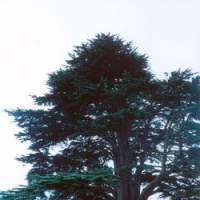I was in Britain from July 6 to July 13 this summer, and on the Saturday of July 8, my companions and I stayed at Baskerville Hall just outside Hay-on-Wye, a beautiful and very historic little town in the Welsh county of Powys on the border with England.
Originally named Cyro Court, Baskerville Hall was built in 1839, and to this day it would most likely be just another huge and ornate early Victorian edifice had it not been for Sir Arthur Conan Doyle, who often stayed there as a guest of its owners, the Baskerville family. While visiting his friends, it is said that the creator of the legendary detective Sherlock Holmes heard a tale of local folklore that he transformed into his 1902 novel, "The Hound of the Baskervilles." Oddly enough, though, he set the book far to the southwest, in Devon -- apparently at the request of his hosts, "to ward off tourists."
I didn't hear any ghostly hounds baying, perhaps because that weekend the hall (now a hotel) was hosting a bikers' convention, and there was enough skull-splitting rock music, yelling, cursing, loud and raucous singing -- not to mention the odd fight in the corridors -- to drown out or scare off the fiercest of howling or marauding nocturnal beasts.
In the quiet of the morning I stepped out for some fresh air and was delighted and awed to see a magnificent Lebanon cedar. From the size of it, I at first doubted that such a huge tree could have been planted as late as 1839, but on reading up on it back at home in the Nagano Prefecture hills, I found I was probably mistaken.
The soil that tree was rooted in was fertile, on a south-facing slope, and there was ample rain, so despite my initial skepticism, it might well have made that girth in 170 years or so. Also, the landscaper, presuming there was one, would have planted a young tree of a few years growth.
Lebanon cedars were reportedly brought live to Britain for the first time in 1638, but a notoriously severe frost and heavy snows in 1740 killed nearly all of them. Then, between 1760 to 1820, a fashion spread among wealthy landowners to plant Lebanon cedars on their lawns and drives. So when Baskerville Hall was built, it was probably quite the thing to do.
Spire-like saplings
Lebanon cedars grow first as slender, spire-like saplings, then, once established, they can start to gain girth very quickly indeed. The Lebanon cedar is one of the four true species of Old World cedars. The many other species of cypresses, junipers, and redwoods -- as well as our Japanese cedar, called sugi -- are actually different species. The Lebanon cedar has slender, sharp needles, set in spirals around new shoots but in whorls of 40 to 50 along older shoots. The tiny female flower, pale pink or bright green, takes a year to become a 12-cm-tall blue-green cone, which then takes another year to turn woody and dark brown. In Britain, the Lebanon cedar flowers in autumn. Male flowers stand erect above the flat array of foliage, green and blue-gray during summer, then maturing and growing heavy with pollen in October.
The fame of these mighty cedars in Britain and the rest of Europe, the Middle East and probably further afield, far predates the 17th century. Gilgamesh, the legendary hero and King of Sumaria and Babylon some time around 2,700 B.C., is reputed to have brought huge rafts of Lebanon cedars by river and sea to build his palaces and temples. Quite a bit later on, as recorded in the Old Testament's "Book of Kings," there are also several references to Lebanon cedars and King Solomon. As a boy, listening to verses from the Old Testament, I used to imagine the forests these tress came from.
According the Bible, in the fourth year of his reign, sometime around 1,000 B.C., King Solomon raised a levy of 30,000 men, artisans and laborers, and sent 10,000 at time for a month each to hew masonry, cedars and fir trees to make a great temple in Jerusalem. Solomon's workers also used rafts to transport the timber by river and sea. The verses describe how the temple walls were of cedar, the floors planked with fir, and how the cedar of the inner temple was intricately carved with knops of flowers. (I had to look up that word; a "knop" is an ornamental boss, as in protuberance . . . the thought struck me that a few human bosses might be referred to as "knops" -- ornamental protuberances that they are.) Solomon also built a splendid palace of Lebanon cedar -- from the verses in the "Book of Kings," it must have been awesome.
The Lebanon cedar in the grounds of Baskerville Hall had been trimmed a little. Perhaps a couple of the heavy lower branches had cracked and needed surgery. Whatever, some sticky sap exuded, and it had the most pleasant, aromatic scent. The Japanese sugi (Cryptomeria) also has a lovely aromatic smell, which can last for hundreds of years in trunks buried underground. The famed sugi of Yakushima Island southeast of Kyushu, perhaps the greatest and oldest trees surviving on our planet, are specially known for this. (Some folk might want to argue with me about these being the world's oldest trees, but the Jomon Sugi on Yakushima Island is said to be over 7,000 years old.)
Recently, while I was in Shimane Prefecture, I visited an excavation at a place called Sanbe Azukihara of some mighty sugi from the Jomon Period (circa. 8,000-300 B.C.) that were buried by a volcanic eruption about 3,500 years ago. Among the trees uncovered were some giants that were still standing -- one of which had 636 annual growth rings. There was a section of timber cut from one of these trees on open display and, incredibly enough, it was still aromatic.
To me, the scent of a Lebanon cedar is even more pleasant. Imagine what a whole temple or a palace of the stuff would smell like!
Once-lovely country
Although it is the cedar of Lebanon that adorns the flag of that country, a republic that gained independence from Syria and France in 1946, the images most likely to come to mind nowadays are not of forests, temples and palaces, but of war, tanks, missiles, bombs, destroyed cities and homes, terrible loss and suffering, and of faces filled with fear, grief, grim determination or hatred.
When I first went to work in Ethiopia in the late 1960s, a French doctor told me that if I wanted to have a "decent, civilized, friendly and entirely pleasant holiday," then I should go to Beirut and travel around the countryside in a car. Whether you want to call them freedom fighters, jihadists or terrorists, it didn't take long for them to take over and for them and their various foes to destroy a once-lovely country.
Mr. Matsuki, our woodland trust forester, and I have a secret place in our woods here in Kurohime where we are nurturing 10 young Lebanon cedars. I suspect our winters of deep snow might be tough on them, but so far they are doing fine. Some purists may deride the planting of non-native trees in Japan, but for us, although by far the majority of our trees are indeed native, we also like to plant a little bit of planet Earth's history, in order to show future students what certain famous trees, like Lebanon cedars or British oaks, are like. Besides, they are not likely to grow rampant and take over the whole of Nagano Prefecture, are they now?
With that little planting, I have a prayer and perhaps a forlorn hope that a time may come when torn and tortured Lebanon will once again have enough huge cedars to rebuild with. If such a dream ever came to pass, then may Lebanon be graced with fine buildings for homes, schools, hospitals and hospices; places of life, learning, healing and peace. Meanwhile, we will nurture our trees and hope that humanity can somehow find sanity.




















With your current subscription plan you can comment on stories. However, before writing your first comment, please create a display name in the Profile section of your subscriber account page.